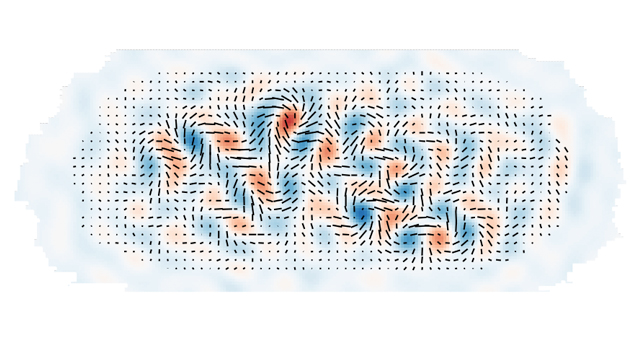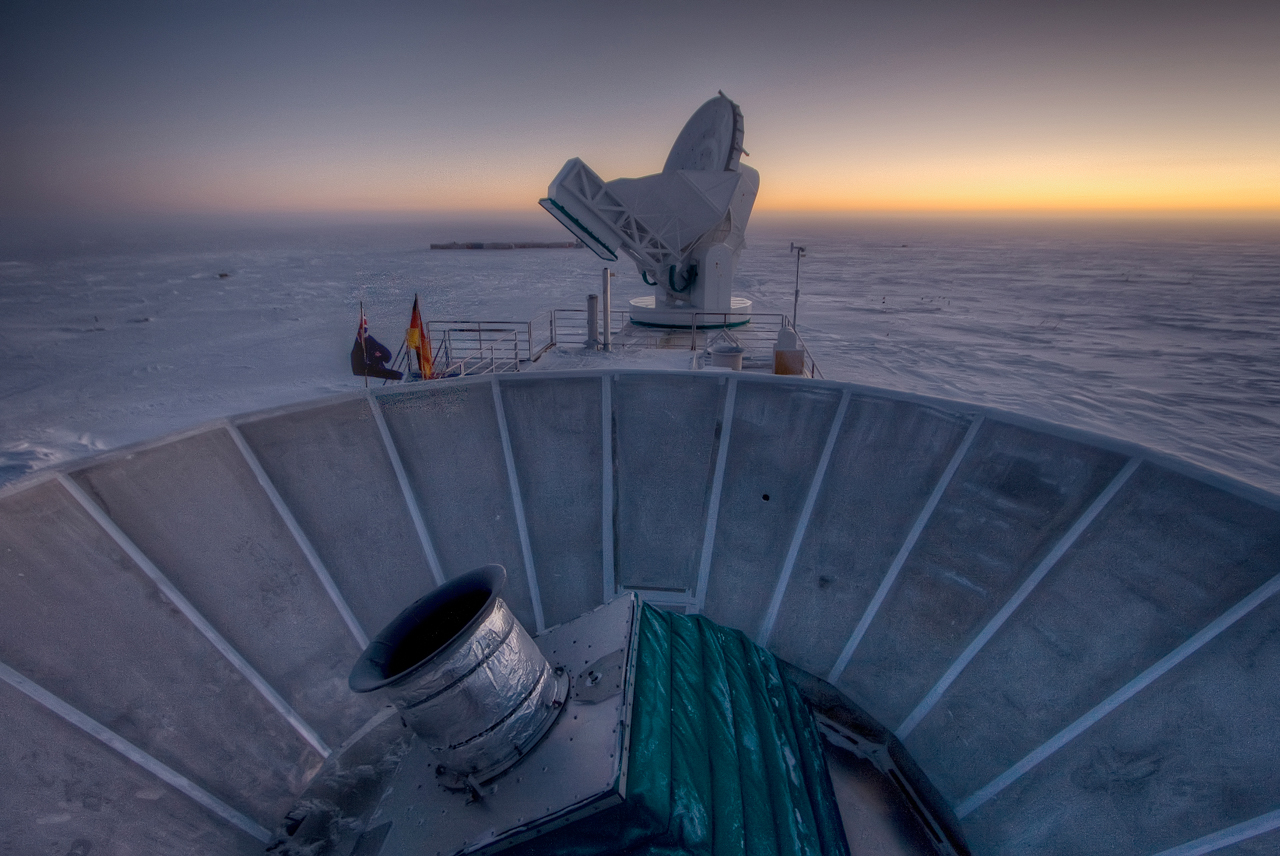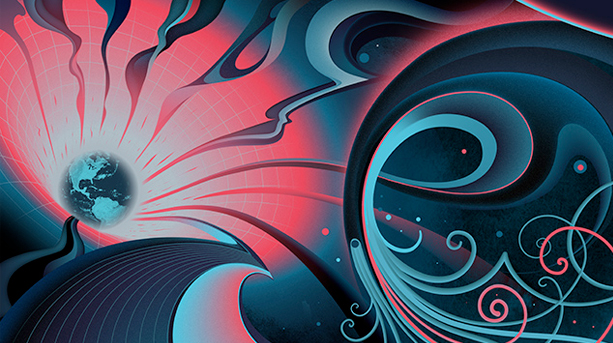Possible Echo of Big Bang Detected

Editor’s note: In the months after this article appeared, further analysis of the BICEP2 data has revealed that the signal is most likely due to dust, not gravitational waves. For additional coverage of this issue, please see our articles “‘Big Bang Signal’ Could Be All Dust” and “Joint Dust Analysis Deflates Big Bang Signal.”
A telescope at the South Pole has detected subtle swirls in ancient light that have the potential to reveal how the universe began and point toward a grand unified theory of physics, scientists reported today.
“If confirmed,” said Frank Wilczek, a Nobel Prize-winning physicist at the Massachusetts Institute of Technology, “it would be one of the absolute greatest discoveries in cosmology.”
Using the Bicep2 telescope, scientists at the Harvard-Smithsonian Center for Astrophysics and other institutions discovered that microwave radiation coming from the early universe exhibits a type of polarization that is expected to result from primordial gravitational waves, the scientists said. These waves — ripples in the fabric of space and time — became imprinted on the shape of the universe during “inflation,” a period of rapid expansion during the universe’s first instant.

Theoretical physicists pointed out decades ago that primordial gravitational waves might have polarized light from the early universe, but no one knew if the signal would be strong enough to detect.
“The implications for this detection stagger the mind,” said Jamie Bock, a physicist at Caltech and project co-leader. “We are measuring a signal that comes from the dawn of time.”
Though there is little doubt that the microwaves exhibit the swirl pattern, called B-mode polarization, an independent observation is needed to rule out other possible sources for the signal and confirm that it comes from primordial gravitational waves. But researchers say the new results will drive other experiments to home in and potentially confirm the discovery with statistical certainty within a year. If verified, this direct evidence of gravitational waves would prove inflation happened, experts said. And because the size of the waves depends on how forcefully the universe inflated, they also reveal the amount of energy that infused it and drove it apart — a major clue as to why it happened.
The size of the B-modes detected by Bicep2 indicates that inflation occurred when the universe was approximately 10-37 seconds old and packed with 2 x 1016 giga-electron-volts of energy. Although this energy scale is 20 trillion times higher than physicists have probed in lab experiments, it is strikingly familiar to many in the field. Researchers discovered in the 1970s and 1980s that three of the forces of nature attain equal strengths and unite into a single force at exactly this energy scale, as long as the known laws of physics are rounded out with a few missing parts. The coincidence is leading many physicists to wonder whether the breakup of this “grand unified” force into distinct types could have triggered inflation.
“A B-mode detection would provide strong hints that the new physics responsible for inflation may involve grand unification,” said Marc Kamionkowski, a professor of physics and astronomy at Johns Hopkins University, referring to the theory that the forces of nature were merged together at the beginning of time.
Kamionkowski helped conceive the plan to look for B-modes as evidence of gravitational waves in the late 1990s, motivating experimental efforts like Bicep2. “Although I’m trying to be sober, it’s extremely exciting to think that we may be seeing a new relic from 10-37 seconds after the Big Bang, and even more so to think that I may have had some sort of role in the advance,” he said in an email.
To find evidence of primordial B-modes, John Kovac of Harvard University, the principal investigator of Bicep2, and his team looked for variations in the cosmic microwave background radiation — the faint afterglow of the moment the universe became transparent, 380,000 years after the Big Bang. This was when the opaque soup of charged particles that filled the cosmos cooled down enough to congeal into neutral atoms, freeing light to travel unimpeded through space for the first time. This light is still raining down on Earth from every direction, its polarization indicating the shape of space-time at the point where it last ricocheted off of a particle in the early universe.
The coarse-grained swirl pattern found in the light’s polarization matched the effects of giant buckles in space-time — gravitational waves that stretched to enormous proportions during inflation.
“The story that we’re testing here seems so fantastical,” Kovac said today at a press conference in Cambridge, Mass. “The extrapolation from the physics that we understand to testable predictions about such an incredibly exotic regime — the beginning of our universe — we needed a lot of convincing to believe that the signal was real. But by the end of December, the data was passing each of our tests.”
The gravitational waves arose because, according to quantum mechanics, particles randomly pop in and out of existence, and gravity particles that arise in this way send cascades of ripples through space-time like pebbles striking the surface of a pond. When these particles arose during inflation, the ripples became imprinted and magnified as space-time expanded. The exact amount the ripples stretched, and the resulting size of the B-mode swirl pattern observed by Bicep2, reveals how energetically space-time inflated. This in turn helps theorists figure out why it did so.
Other experiments, such as a project called Cosmology Large-Angular Scale Surveyor led by researchers at Johns Hopkins, hope to characterize even bigger buckles in space-time, which would correspond to the energy density of the universe even earlier in inflation. These experiments “will thus in tandem help us infer something about how inflation evolved,” Kamionkowski said. “The details of what we find will then help us zero in on the correct model of inflation.”
The theory of inflation was originally invoked by Alan Guth, a physicist at the Massachusetts Institute of Technology, and others to explain the smoothness of the universe. Inflation probably occurred because an entity called an inflation field that permeated the new universe suddenly became infused with energy, blowing it up like a balloon under pressure. Many ideas exist about how this inflation field fits in with the rest of physics. The new clue suggests that the same phase change that split the strong, weak and electromagnetic forces apart could also have inflated the universe and perhaps jiggled the values of a few fundamental constants as well, in a way that reduced the perfect symmetry of the original laws of physics. Adam Falkowski, a theoretical physicist at CERN Laboratory, and other theorists said they expect a surge of new ideas tying these processes together.
As an added bonus, the discovery of primordial gravitational waves would strongly suggest that the force of gravity really does come from quantum particles called gravitons. “If we can show these B-modes are due to gravitational waves and show they are due to inflation, then we can show that gravity is quantized,” said Lawrence Krauss, a theoretical physicist and cosmologist at Arizona State University, who detailed this possibility in a January paper co-authored by Wilczek. “Gravitons exist.”
Detecting primordial gravitational waves “would get us a lot closer to the origin of the universe,” said Wilczek. “It would be both a milestone and a platform for further exploration. But it’s important that it gets confirmed before we get carried away.”



